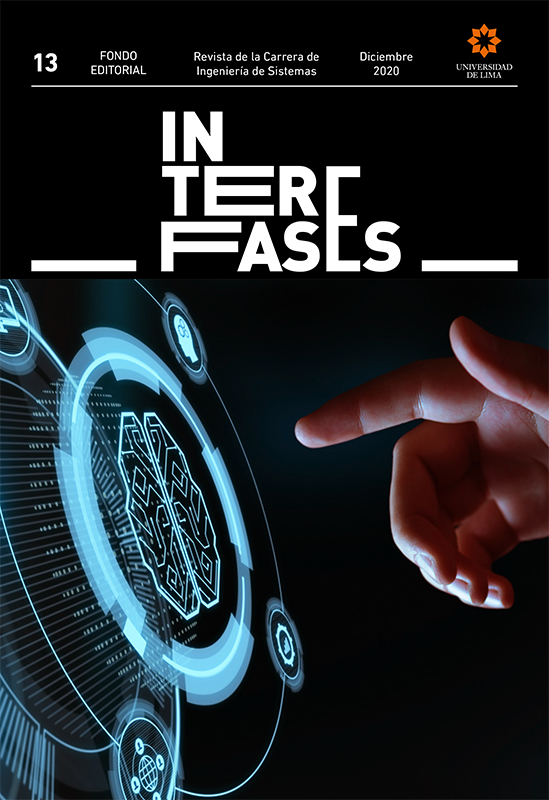Balanced Scorecard model for critical computer security controls according to the Center for Internet Security (CIS)
DOI:
https://doi.org/10.26439/interfases2020.n013.4876Keywords:
Compliance, security and privacy, organizational modelingAbstract
In different sectors of human activities, organizations are adopting information technology (IT) more intensively, exposing sensitive and confidential information of employees and customers. This situation makes public and private entities to develop standards and regulations to protect these information assets, ensuring confidentiality, integrity and availability. As a result of the study, a Balanced Scorecard model that links the critical security controls of the CIS is formulated and supported by an office IT application as a preliminary tool that facilitates the presentation of the results. Such results highlight that the highest proportion (80%) of the preliminary application that occurred in five institutions agrees with the proposed model and its usefulness for monitoring and managing security controls.
Downloads
References
AT&T Cybersecurity. (2020). AlienVault OSSIM. Recuperado de https://cybersecurity.att.com/products/ossim
Caudle, S. (2008). The Balanced Scorecard: A Strategic Tool in Implementing Homeland Security Strategies. Homeland Security Affairs, 4(3).
CIS (Center for Internet Security). (2018). Homepage. Recuperado de https://www.cisecurity.org/
CNSS. (2015). Committee on National Security Systems (CNSS) Glossary. CNSS Instruction.
https://doi.org/10.1016/0020-7292(88)90192-0
DeLooze, L. L. (2006). Creating a Balanced Scorecard for Computer Security. 2006 IEEE Information Assurance Workshop, 15-18. https://doi.org/10.1109/IAW.2006.1652071
Grembergen, W. Van. (2005). Strategies for information technology governance. (J. Travers, M. Khosrow-Pour y A. Appicello, Eds.). Londres: Idea Group Inc. https://doi.org/10.4018/978-1-59140-140-7
Groš, S. (2019). A Critical View on CIS Controls. Cornell University. Recuperado de http://arxiv.org/abs/1910.01721
Gutzwiller, R. S., Hunt, S. M. y Lange, D. S. (2016). A Task Analysis toward Characterizing Cyber-Cognitive Situation Awareness (CCSA) in Cyber Defense Analysts. 2016 IEEE International Multi-Disciplinary Conference on Cognitive Methods in Situation Awareness and Decision Support, CogSIMA 2016, (Marzo), 14-20. https://doi.org/10.1109/COGSIMA.2016.7497780
Herath, T., Herath, H. y Bremser, W. G. (2010). Balanced Scorecard Implementation of Security Strategies: A Framework for IT Security Performance Management. Information Systems Management, 27(1), 72-81. https://doi.org/10.1080/10580530903455247
IBM. (2020). Security information and event management (SIEM). Recuperado de https://www.ibm.com/security/security-intelligence
Indecopi. (2014). Norma Técnica Peruana NTP-ISO/IEC 27001-2014. Tecnología de la Información. Lima: Indecopi.
Industria de tarjetas de pago (PCI). Norma de seguridad de datos. Requisitos y procedimientos de evaluación de seguridad. Versión 3.2. (2016). PCI Securiry Standards Council. Recuperado de https://es.pcisecuritystandards.org/_onelink_/pcisecurity/en2es/minisite/en/docs/PCI_DSS_v3-2_es-LA.pdf
ISO/IEC. (2013). International Standard ISO/IEC-27002-2013. Switzerland.
Johnson, L. (2015). Security Controls Evaluation, Testing, and Assessment Handbook. (C. Katsaropoulos, Ed.), Security Controls Evaluation, Testing, and AssessmentHandbook. Walthman: Elsevier. https://doi.org/10.1016/C2013-0-13416-2
Kaplan, R. y Norton, D. (2002). Cuadro de Mando Integral (The Balanced Scorecard). Barcelona: Ediciones Gestion 2000.
Kaplan, R. S. y Norton, D. P. (1996). The Balanced Scorecard: Translating Strategy Into Action. Proceedings of the IEEE. https://doi.org/10.1109/JPROC.1997.628729
Kaplan, R. S. y Norton, D. P. (2005). Cómo utilizar el Cuadro de Mando Integral. Barcelona: Gestión 2000.
Keyes, J. (2005). Implementing the IT Balanced Scorecard. Auerbach Publications (first). Florida: Auerbach Publications. Recuperado de http://doi.wiley.com/10.1002/jcaf.20198
Marchand-Niño, W. R. (2013). Metodología de implantación del modelo Balanced Scorecard para la gestión estratégica de TIC. Caso: Universidad Nacional Agraria de la Selva. PIRHUA-Universidad de Piura. Recuperado de https://hdl.handle.net/11042/1842
Martinsons, M., Davison, R. y Tse, D. (1999). The Balanced Scorecard: a Foundation for the Strategic Management of Information Systems. Decision Support Systems, 25(1), 71-88. https://doi.org/10.1016/S0167-9236(98)00086-4
Montesino, R., Fenz, S. y Baluja, W. (2012). SIEM-based framework for security controls automation. Information Management & Computer Security, 20(4), 248-263. https://doi.org/10.1108/09685221211267639
NIST Special Publication 800-53 Revision 4 Security and Privacy Controls for Federal Information Systems and Organizations. Sp-800-53Ar4, 462. (2014). National Institute of Standards and Technology https://doi.org/10.6028/NIST.SP.800-53Ar4
Perminov, P., Kosachenko, T., Konev, A., & Shelupanov, A. (2020). Automation of Information Security Audit in the Information System on the Example of a Standard “cis Palo Alto 8 Firewall Benchmark.” International Journal of Advanced Trends in Computer Science and Engineering, 9(2), 2085–2088. https://doi.org/10.30534/ijatcse/2020/182922020
Splunk® Enterprise Security (2020). Splunk. Recuperado de https://www.splunk.com/en_us/software/enterprise-security.htm
Downloads
Published
Issue
Section
License
Authors who publish with this journal agree to the following terms:
Authors retain copyright and grant the journal right of first publication with the work simultaneously licensed under an Attribution 4.0 International (CC BY 4.0) License. that allows others to share the work with an acknowledgement of the work's authorship and initial publication in this journal.
Authors are able to enter into separate, additional contractual arrangements for the non-exclusive distribution of the journal's published version of the work (e.g., post it to an institutional repository or publish it in a book), with an acknowledgement of its initial publication in this journal.
Authors are permitted and encouraged to post their work online (e.g., in institutional repositories or on their website) prior to and during the submission process, as it can lead to productive exchanges, as well as earlier and greater citation of published work (See The Effect of Open Access).
Last updated 03/05/21


